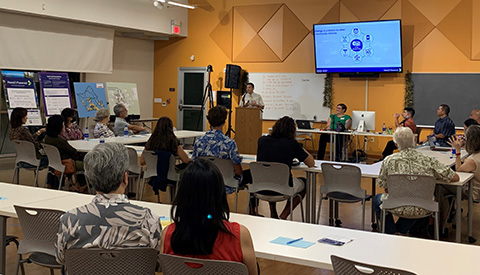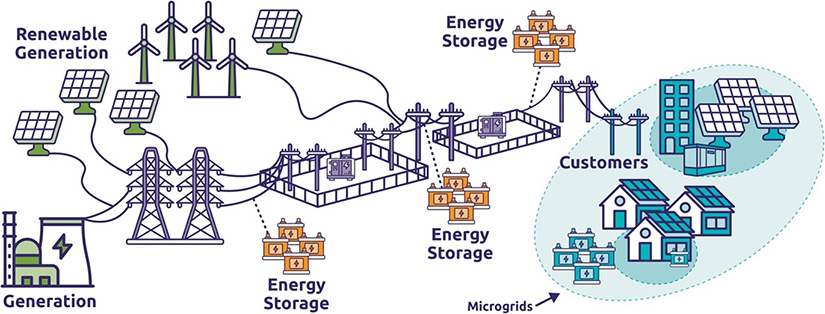Perspective Pivot: Mapping a Landscape of Voices in Oahu Changes Energy Planning
At the National Renewable Energy Laboratory (NREL), researchers often serve as guides who help communities navigate the world of renewable energy solutions. But in community-based technical assistance projects, the guiding role goes both ways: Researchers need local perspectives to fill contextual knowledge gaps and create more meaningful energy solutions.
“Energy problems are people problems. We prioritize the interests of people and develop tools to serve them,” said Katy Waechter, an NREL researcher whose people-focused lens helped her team make critical adjustments during an energy resilience project for the island of Oahu in Hawaii.

Over the course of six weeks, Waechter—along with representatives from the Hawaiian Electric utility and Hawaii Natural Energy Institute, affiliated with the University of Hawaii—traveled the 600-square-mile island to hear how individuals perceived independently owned hybrid microgrids. No amount of preliminary research could prepare the team for what they discovered: candid concerns, fresh perspectives, and previously uncharted priorities that ultimately pivoted the team’s research direction to better inform Oahu-wide energy planning.
Oahu was among the first 11 communities in the United States to join the U.S. Department of Energy’s Energy Transitions Initiative Partnership Project (ETIPP), a technical assistance program for community-driven energy resilience projects that combines the local knowledge of regional organizations with the expertise of national laboratory researchers. Each ETIPP project is shaped by a community’s priorities and nuances, including elements such as energy resources, cultural heritage, socioeconomic factors, and resilience goals. The technical assistance in Oahu illustrated how when researchers follow residents’ leads instead of taking standard approaches, they can help facilitate energy planning that will best serve local needs in the long-term.
Exploring Hybrid Microgrids as a Solution to Oahu’s Power Outages
Living in an isolated community with limited electrical infrastructure, some Oahu residents wait weeks for power to be restored after severe weather events. The local utility, Hawaiian Electric applied to ETIPP with a vision to bring hybrid microgrids to the island to help alleviate long outages.
Hawaiian Electric hoped microgrid siting discussions would inform the Oahu-wide energy planning conversation about reaching 100% renewable energy by 2045—specifically, how to equitably distribute the benefits and burdens associated with the transition.
“Making sure that a renewable energy transition is done in an equitable manner is something that a lot of utilities and partners are acknowledging that needs to be done, and ETIPP is designed in a way to encourage that cocreation process with the community,” said Kurt Tsue, Hawaiian Electric’s director of community affairs, who collaborated on the ETIPP project.

With the support of ETIPP researchers at NREL and Sandia National Laboratories, Hawaiian Electric planned to evaluate optimal hybrid microgrid locations to improve the resilience of Oahu’s electrical infrastructure. Unlike traditional microgrids, which are installed and operated by utilities, hybrid microgrids in Hawaii are developed and operated independently, which means residents must initiate the request to develop them. But hybrid microgrids are a new service in Oahu, so many residents are not yet aware they are an option. The ETIPP team intended to “help communities learn about hybrid microgrids, how they work, and decide if it’s a solution for them,” Waechter said.
“We were purely working towards designing something with the community and not coming in with any preconceived notions of wanting to build something,” Tsue said.

However, in one of the first meetings the ETIPP research team held with a group of Oahu residents to discuss microgrid options, they discovered many residents’ questions needed to be addressed before they could discuss potential hybrid microgrid locations or participants.
“It became apparent pretty immediately that the concerns of the communities weren’t necessarily being addressed with what we were trying to talk to them about,” Waechter said. “So, we had to pivot the conversation to focus on how hybrid microgrids could benefit and address their concerns about energy reliability and security.
Community members also mentioned a desire to see more diverse representation of the five different Oahu moku (districts)—ʻEwa, Oʻahu, Koʻolauloa, Koʻolaopoko, and Waiʻanae—in island-wide energy planning conversations.
“We have our highest native Hawaiian population on the western side, which has been experiencing more of the renewable transition because the resource potential and land availability is much greater there,” Tsue said. “People in the west ask why everything has to be sited there. They feel that [the renewable energy transition] is being carried on their back.”
Yielding the Floor: Hearing What Matters Most to Residents Across Oahu

NREL researchers worked with Hawaiian Electric as well as Hawaii Natural Energy Institute and the Hawaii Emergency Management Agency to create a community engagement strategy that addressed these concerns. The ETIPP team hosted five meetings, one for each of the regions in Oahu, to enable greater participation. Live broadcasts of the meetings included feedback options via Zoom and social media channels. The team also posted recordings of the meetings to Hawaiian Electric’s website, giving residents the chance to submit comments on their own time.
Though the research team knew what types of facilities would typically be prioritized for inclusion in microgrid coverage—like hospitals and emergency services—they instead asked each regional community to identify what they felt were the priority buildings and services.
“That was my favorite part: learning about the places that matter to these communities,” Waechter said. “That knowledge changed what we mapped and changed what these hybrid microgrid opportunities could potentially cover.”
Some of the priority locations included veteran centers, commercial kitchens, sewer pumps, and a remote dam that serves as a local rallying point during major weather events like tsunamis and hurricanes. Tsue said it was “extremely valuable” to document feedback from community members about places that were important to them.
“Asking about things like resilience hubs or gathering places that are meaningful for communities—those we didn’t have any previous insight on,” Tsue said.
To address logistical challenges to participation, capture a wider audience, and share resources, ETIPP researchers combined their hybrid microgrid information sessions with Hawaiian Electric’s integrated grid planning meetings and other community organization meetings.
“Pairing these microgrid discussions with some of the other renewable energy planning that we were already doing made it even more valuable. It led to really meaningful community discussions,” Tsue said.
All of the community input informed the data collection process that ETIPP researchers used to build a map series showing different types of hybrid microgrid opportunities in each community, as well as island-wide. Whether a hybrid microgrid was considered suitable for a given area was based on current electricity distribution and community needs and whether it would provide improved support for critical services and lifelines, improved service reliability for vulnerable grid infrastructure, and equitable access to microgrid services.

Hawaiian Electric plans to use these materials to conduct further community outreach and extend its microgrid analysis to the other Hawaiian islands in its service territory.
One of the community leaders who participated in Hawaiian Electric’s ETIPP project was inspired to apply to ETIPP the following year to receive support for a specific resilience hub. Hui o Hau’ula, a community organization on the east coast of Oahu, was accepted to ETIPP in 2022 and is coordinating the planning and development of a community resilience hub, which will generate and store power before, during, and after a disaster or power outage for the surrounding Koʻolauloa district.
“ETIPP is a really unique opportunity to empower communities to make decisions for themselves,” Tsue said.
Waechter agreed.
“The work is ultimately to serve communities by giving them a data-driven foundation to make decisions,” she said. “Everything comes down to what people value. The different types of analysis that we do to help people answer questions about their own energy autonomy—it’s really heartening to get to do that.”
ETIPP is managed by NREL and funded and supported by the U.S. Department of Energy’s Office of Energy Efficiency and Renewable Energy.
EL and funded and supported by the U.S. Department of Energy’s Office of Energy Efficiency and Renewable Energy
By Brooke Van Zandt | Courtesy of NREL.

Chip in a few dollars a month to help support independent cleantech coverage that helps to accelerate the cleantech revolution!
Have a tip for CleanTechnica? Want to advertise? Want to suggest a guest for our CleanTech Talk podcast? Contact us here.
Sign up for our daily newsletter for 15 new cleantech stories a day. Or sign up for our weekly one if daily is too frequent.
CleanTechnica uses affiliate links. See our policy here.
CleanTechnica's Comment Policy

